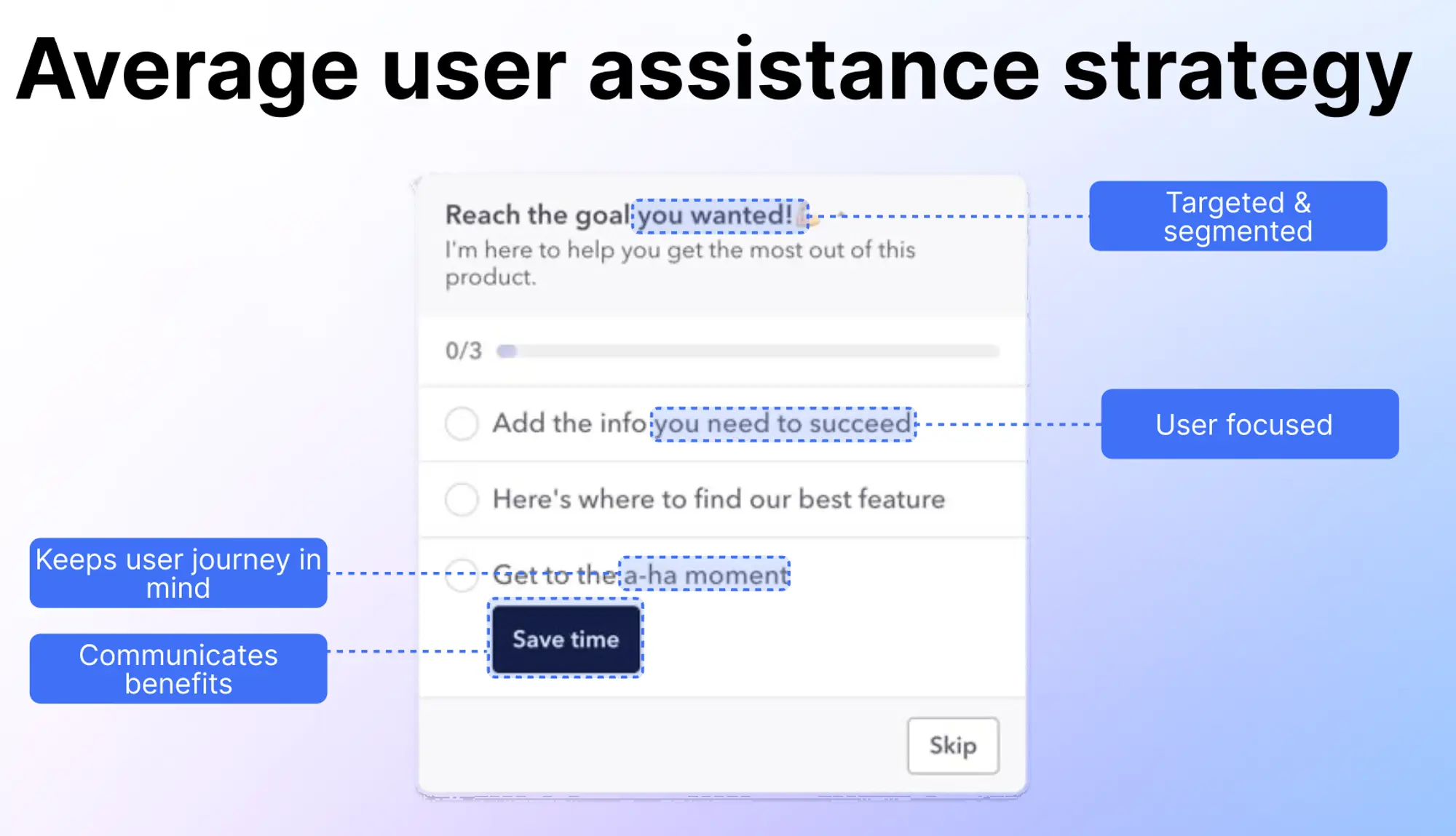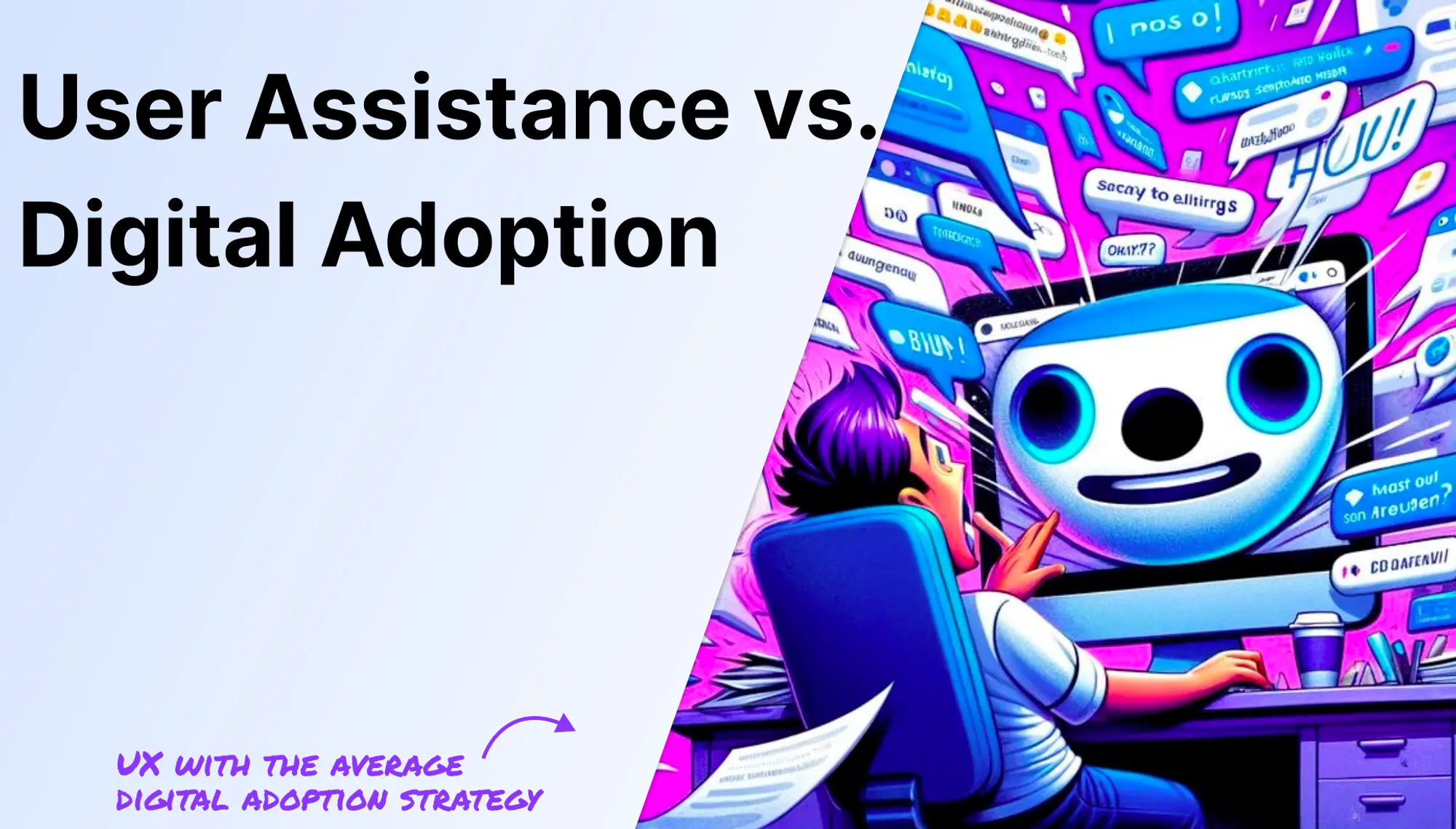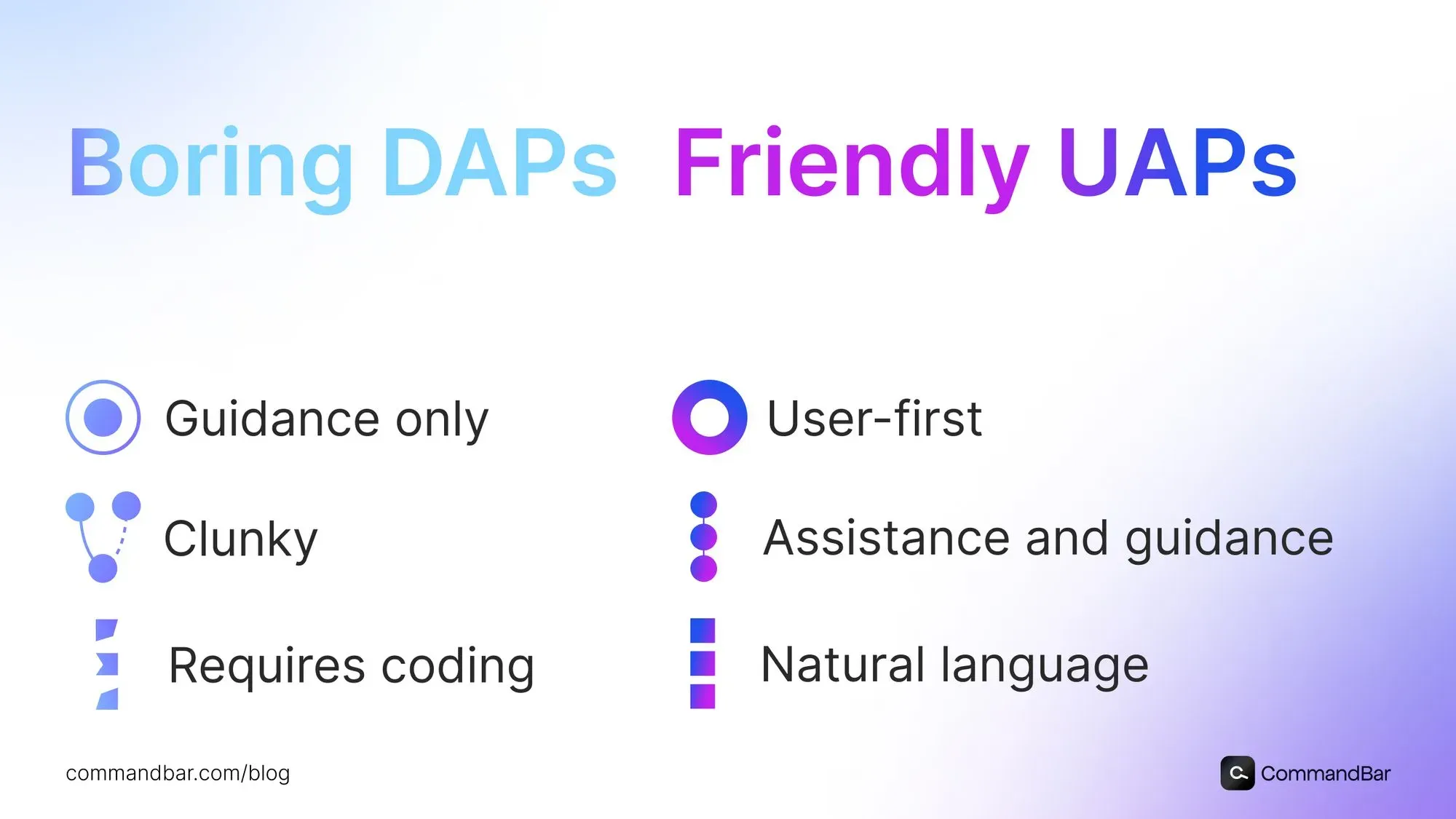Not everyone is as excited about digital adoption as us. Few product managers go weak in the knees when you say "product tours". The hairs on their backs don't stand up for "onboarding checklist".
But that's because digital adoption has historically been annoying: You spent a long time desigining experiences, had engineers work on them for weeks—and then didn't even see results.
But digital adoption doesn't have to suck that much.

That said, the DAP landscape has evolved rapidly over the past couple of years, and there are now a host of innovative and no / low code tactics that are game changers for improving your user experience in hours, not months.
This shift towards what we call User Assistance (Command AI is a User Assistance Platform!) represents the most fundamental shift in the digital adoption space since the creation of the original DAPs back in the 2000s.

So, let's talk about how you can craft a DAP strategy, and if you care about your users like us, how you can evolve that into a UAP strategy that will propel you above your competition.
Do you really need a DAP strategy?
“Sure Hugo,” you might say, “there are lots of new tools out there, but why on Earth do I actually need to craft a DAP strategy? Can't I just do a couple demos, see which one looks cool and then purchase it, set up some pop-ups and call it a day?”
Well, you could!
BUT, you'd be leaving an unbelievable amount of valuable user information and analytics on the table, and therefore missing out on some huge opportunities to improve your UX.
Plus, your user experience might look like this:

If you're as passionate about user friendliness and user assistance as we are, then you'll want to be sure to craft a DAP strategy that matches your product’s specific use case, blockers, and needs with the right DAP.
Unsure of how to do that?
In the next few minutes of reading, you'll learn everything you need to know to craft the perfect DAP strategy for your business.
One quick note before we dive in:
You might know DAPs as the internal employee digital adoption platforms that are used when your company integrates new software and which are mostly focused on prescriptive compliance (and which make you want to tear your hair out at times!)
In this article we're focusing on user digital adoption platforms and strategies.
If you're here looking for advice on how to make pop-up modules to force feed down your employees throats, you've come to the wrong place partner.
Identify your needs
Before you can even begin to look at DAPs and evaluate them, you need to first clarify and write out your goals for your DAP. That’s because the DAP that is right for an iOS app will be very different from that of a major multinational enterprise. You’ll need to do some self-discovery with your team and leadership to figure out what you want to achieve with your DAP.
A good place to start is with these 5 questions:
- What are the current areas within your product where users get blocked, frustrated, or report experiences as being ineffective or under optimized?
- Onboarding?
- Activation?
- Feedback collection?
- Product roll-outs?
- All of the above, or something else?
- What are the core tactics you want to use?
- In-app messages
- Tool-tips
- Product tours
- AI Copilot / Assistant
- Pop-ups
- AI-powered search
- Customer chat
- Who will be in charge of building the experiences?
- Do you have development resources available?
- Do you need your non-technical marketers and support folks to be able to work in the tool?
- What is your price range and budget?
- How will you measure the success of your DAP?
- What are the goals and metrics you want to see improved?
- What is “success mode” for your DAP Strategy?
- What does failure mode for your DAP Strategy look like?
If you can produce a one pager that concisely captures answers to this set of questions, you're well on your way to crafting a coherent strategy.
But before you can properly conduct an evaluation and make a purchasing decision, it's important to understand the key criteria that you should assess DAP step by step.
What to look for when you evaluate a DAP or UAP
DAPs are not one size fits all: they vary greatly in ease of use, price, functionality and development resources needed.
We have a great standalone article on how to set criteria and choose between the top DAPs. We will offer a concise summary here of the key criteria you can use to evaluate each step:
Actually cares about your users
- This is by far the most important criteria when you're evaluating a DAP
- How delightful are the end users' experiences that you create? Would you love them yourself?
- How easy to use and customizable is the user experience for your team?
- How well does the experience design of the DAP mesh with your product design and aesthetic?
Integration into your tech stack
- Choose a DAP that integrates well with current software to avoid extensive development time.
- Ensure the platform supports various applications as needed, such as web, desktop, or mobile.
Great, non-technical friendly UX
- Prioritize an intuitive interface so non-technical staff can easily create and modify content.
- Evaluate if the DAP allows for lots of customization and segmentation without development resources
- Look for customization options that align with the company’s branding and aesthetics.
Scalability
- Opt for a DAP that can scale with the company’s growth to avoid the need for future platform changes.
Data insights
- The platform should offer robust analytics on platform or with integrations so you can decipher user behavior and provide actionable insights from data like survey feedback.
Customer support
- Ensure the DAP provider offers efficient customer support for quick problem resolution and uninterrupted user experience.
The best DAP strategy is a …. UAP strategy
You want better user activation, satisfaction, and retention, and most importantly you want your users to f****** love your product.
You know you need a DAP, so you built your one pager, set your criteria and constraints, and started checking out platforms
You stress tested each platform against your one pager and your criteria to figure out which one hits the most boxes.
But, you quickly realized that in 2023 every DAP can:
- Build a pop-up
- Run a survey.
- Collect your NPS data
That’s table stakes, the bare minimum, the “old college try,” and sadly a lot of DAPs want you to pay hundreds of thousands of dollars and commit hundreds of dev hours to earn the right to use their clunky and outdated software.
Don’t settle for a boring, overpriced DAP that just does guidance — go for true user assistance
You’re on the CommandBlogue, so it should come as no surprise that we proudly believe that Command AI is the leader in this space.
But that’s not from one random survey or award we've gotten (although our G2 reviews are 🔥!)
We prioritize the end-user experience, and we have consistently found that that produces better outcomes for companies.
We also bring that user-first mentality into our own digital product design. Every member of your team can quickly spin up in-product experiences using nudges, tool tips, product tours, surveys, and more.
But wait, there’s more…
Yes, CB has proactive guidance (nudges), but we also let users summon help with their own words, which is inherently less annoying because it’s clear what the user wants; you aren’t guessing.
For example, when you add our AI Copilot into your product and sync all of your internal documentation, help resources, and more, your users can interact and chat with this knowledge and get fast and easy answers to their questions.
What's so powerful about this is that you and your team can analyze these conversations, blockages, and dead ends, in real human language, as opposed to simply relying on aggregate quantitative metrics.
This allows you to reach another level of user understanding and to power your product decision making based on real life examples instead of inferences from data points.

Ditch DAPs and go UAP — you’ll never go back
The shift from DAP to UAP reflects a significant change in how to think about user experience.
A thoughtful DAP/UAP strategy puts users at the forefront; it's an investment in understanding and responding to user needs, behaviors, and feedback.
By asking the right questions and evaluating potential platforms against specific criteria, organizations can find a UAP that not only fits their immediate needs but also supports long-term growth and user satisfaction.
Command AI exemplifies the potential of UAPs to revolutionize user engagement by providing intuitive, AI-enhanced tools that enable both users and product teams to have more meaningful interactions with the software. We go beyond basic analytics to a deeper comprehension of user experiences, harnessing the power of AI to turn conversations and user interactions into actionable insights for you and your team.
By creating a strong UAP strategy and adopting Command AI, you can ensure that you’re not just meeting but anticipating user needs, leading to higher satisfaction and retention.

















